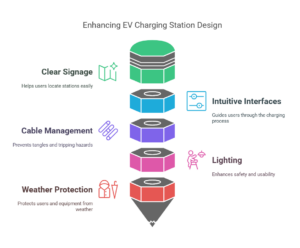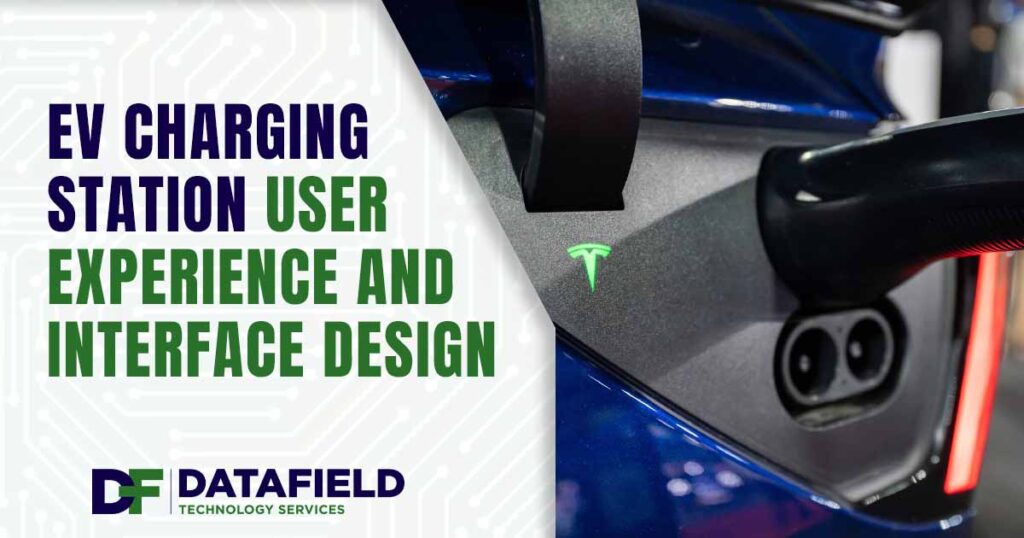The success of an EV charging station extends beyond hardware and power infrastructure; it relies heavily on the user experience (UX) and interface design. A user-friendly EV charging station ensures that the process of locating, accessing, and using chargers is seamless, intuitive, and inclusive. By focusing on clear signage, simple interfaces, app integration, and accessibility compliance, charging station operators can create a positive experience that encourages adoption and builds user trust.
Creating a User-Friendly EV Charging Station
Designing a user-friendly EV charging station involves prioritizing the ease and efficiency of the charging process for every driver. Intuitive design elements simplify navigation, reduce confusion, and enhance overall satisfaction.
- Clear Signage and Wayfinding: Proper signage helps users locate charging stations easily, both from nearby roads and within large parking areas. Signs should include clear directions, visible branding, and universally understood symbols.
- Intuitive Charger Interfaces: Charging stations should feature simple, easy-to-navigate interfaces that guide users through the charging process. Step-by-step instructions, displayed on screens or panels, ensure that even first-time EV drivers can charge their vehicles without difficulty.
- Streamlined Cable Management: Chargers equipped with retractable cables or cable management systems prevent tangles and tripping hazards, keeping the station organized and safe.
- Lighting for Safety and Usability: Well-lit charging areas enhance safety for users, particularly at night. Adequate lighting also makes it easier to read instructions, operate chargers, and navigate the station.
- Weather Protection: Adding canopies or shelters protects users and equipment from adverse weather, making the station usable year-round in various climates.

App Integration and Digital Payment Options
Mobile apps and digital payment systems have revolutionized the EV charging experience, offering users convenience, transparency, and control. These technologies streamline interactions with charging stations and provide valuable real-time information.
- Mobile App Features: Integrated apps allow users to locate nearby chargers, view real-time availability, and receive notifications about charging status. Apps can also offer additional features such as route planning, estimated charging times, and pricing transparency.
- Real-Time Data Access: Mobile apps provide users with critical data, such as energy usage, charging speed, and session duration. This empowers drivers to make informed decisions and optimize their charging sessions.
- Multiple Payment Options: EV charging stations should support a variety of payment methods, including credit/debit cards, mobile wallets, RFID cards, and app-based accounts. Offering multiple payment options caters to diverse user preferences and simplifies transactions.
- Dynamic Pricing Models: Integration of dynamic pricing allows stations to adjust rates based on demand, energy costs, and time of day. Apps can display this information clearly, ensuring pricing transparency for users.
- Subscription Services: Many apps offer subscription-based models that provide users with discounted rates, unlimited charging sessions, or access to exclusive stations. This creates a loyalty-driven relationship between operators and users.
Accessibility and ADA Compliance
Ensuring accessibility is not just a legal requirement; it’s a fundamental aspect of creating an inclusive user experience. ADA-compliant charging stations cater to individuals with disabilities, making EV infrastructure usable by all.
- Accessible Parking Spaces: Designated EV charging spaces should be wide enough to accommodate vehicles with ramps or lifts, ensuring easy access for users with mobility challenges.
- Reachable Charger Interfaces: Buttons, screens, and connectors must be positioned at accessible heights, allowing all users, including those in wheelchairs, to operate them comfortably.
- Clear Pathways: Charging station layouts should include unobstructed pathways, free of barriers or tripping hazards, to allow for smooth navigation.
- Tactile and Visual Aids: Stations should feature tactile indicators and high-contrast visuals to assist users with visual impairments. These elements ensure that instructions and controls are easily identifiable.
- Auditory Support: Incorporating auditory feedback in charger interfaces helps users with visual impairments navigate and complete the charging process effectively.
- Compliance with ADA Standards: Following ADA guidelines ensures that stations meet regulatory requirements while promoting inclusivity and social responsibility.
Best Practices for Enhancing User Experience
- Conduct User Testing: Regularly gather feedback from EV drivers to identify pain points and improve station design. Testing with diverse user groups ensures inclusivity.
- Maintain Consistency: Consistent branding and interface design across a network of chargers help users recognize and trust the stations.
- Prioritize Speed and Reliability: Fast chargers and dependable systems reduce user frustration and enhance overall satisfaction.
- Provide Multilingual Support: Offering instructions in multiple languages broadens the station’s accessibility to a global audience.
- Offer Customer Support: Stations should provide 24/7 support via phone or chat to address user concerns promptly.
Benefits of a Well-Designed User Experience
Investing in superior user experience and interface design yields numerous benefits for operators and users alike:
- Increased Adoption Rates: An intuitive and accessible charging process encourages EV adoption by reducing barriers for new drivers.
- Enhanced User Loyalty: A positive experience builds trust and loyalty, encouraging users to return to the same network of charging stations.
- Improved Efficiency: Clear signage and intuitive interfaces reduce time spent navigating or troubleshooting, increasing overall station throughput.
- Compliance and Inclusivity: Meeting ADA standards and catering to diverse user needs ensures legal compliance and promotes social equity.
- Boosted Reputation: A user-friendly design elevates the station’s reputation, attracting more users and fostering positive word-of-mouth.
The Future of EV Charging Station Interfaces
As technology advances, the future of EV charging station interfaces promises even greater innovation and user-centric features:
- Voice-Activated Interfaces: Voice commands will simplify the charging process further, offering hands-free operation and accessibility for users with disabilities.
- AI-Driven Personalization: Artificial intelligence will enable stations to learn user preferences, offering tailored recommendations for charging speeds, pricing plans, and nearby amenities.
- Augmented Reality (AR): AR-enabled apps could guide users visually through the charging process, overlaying instructions or navigation cues onto real-world environments.
- Seamless In-Car Integration: Charging stations will increasingly connect with in-car systems, allowing drivers to locate, reserve, and pay for chargers directly from their vehicle dashboards.
- Universal Interoperability: Future interfaces will ensure seamless compatibility across various charger networks and EV models, simplifying the experience for all users.
User experience and interface design are the pillars of a successful EV charging station. By prioritizing intuitive processes, app integration, and accessibility, operators can create an ecosystem that supports all users, fosters trust, and drives the adoption of electric vehicles. As technology continues to evolve, the focus on UX will remain critical in shaping the future of sustainable transportation.


